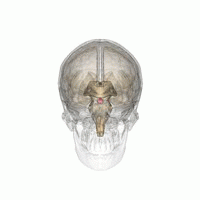
Hyperpituitarism
| Hyperpituitarism | |
|---|---|
 | |
| Pituitary gland | |
| Specialty |
Endocrinology |
| Symptoms | Hirsutism |
| Causes | From a pituitary microadenoma. |
| Diagnostic method | MRI |
| Treatment | Dopamine agonists |
Hyperpituitarism is a condition due to the primary hypersecretion of pituitary hormones; it typically results from a pituitary adenoma. In children with hyperpituitarism, disruption of growth regulation is rare, either because of hormone hypersecretion or because of manifestations caused by local compression of the adenoma.
Symptoms and signs
Symptoms caused by hormone excess and associated mass effects include:
- Acromegaly
- Cushing's disease
- Hirsutism
- Visual field loss or double vision
- Excessive sweating
- Decreased libido
- Lethargy
- Headache
- Male lactation
- Muscle weakness
- Bruisability
Cause
The cause of hyperpituitarism in most cases is due to pituitary adenomas. They usually come from the anterior lobe, are functional and secrete the hormone, GH and prolactin.
Mechanism
Evidence indicates that the mechanism of hyperpituitarism can originate from genetic disruption causing pituitary tumorigenesis, most pituitary adenomas are monoclonal, which in turn indicates their origin from an event in a single cell. There are three hormones that are oversecreted resulting in the pituitary adenoma: prolactin, adrenocorticotropic hormone (ACTH), and growth hormone (GH).
Excess prolactin may result in a prolactinoma Excess GH results in gigantism, the severity of gigantism depends on whether the epiphyseal plate is open. The four most common types of hyperpituitarism are caused by 4 types of pituitary adenoma, as follows: prolactinoma, corticotropinoma (Cushing's disease), somatotropinoma (gigantism), and thyrotropinoma .
Diagnosis
For the diagnosis of hyperpituitarism it depends on the cell type(s) affected, clinical manifestations of hormone excess may include, gigantism or acromegaly, which can be identified by clinical and radiographic results. Cushing's disease diagnosis is done with a physical examination, laboratory tests and X rays of the pituitary glands (to locate tumors) For prolactinoma, diagnosis comes in the form of the measurement of serum prolactin levels and x-ray of pituitary gland.
Treatment
Treatment (for hyperpituitarism) in the case of prolactinoma consists of long-term medical management. Dopamine agonists are strong suppressors of PRL secretion and establish normal gonadal function. It also inhibits tumor cell replication (in some cases causes tumor shrinkage) Treatment for gigantism begins with establishing target goals for IGF-1, transsphenoidal surgery (somatostatin receptor ligands- preoperatively) and postoperative imaging assessment. For Cushing's disease there is surgery to extract the tumor; after surgery, the gland may slowly start to work again, though not always.
See also
Further reading
- Handbook of Medical-surgical Nursing. Lippincott Williams & Wilkins. 2006-01-01. ISBN 9781582554457.
- Atreja, Gaurav; Jain, Nitul; Atreja, ShikhaHanda; Sukhija, Urvashi (2012). "Oral manifestations in growth hormone disorders". Indian Journal of Endocrinology and Metabolism. 16 (3): 381–3. doi:10.4103/2230-8210.95678. PMC 3354844. PMID 22629503.
- Illustrated Manual of Nursing Practice. Lippincott Williams & Wilkins. 2002-01-01. ISBN 9781582550824.
External links
| Hyperpituitarism |
|
||||||
|---|---|---|---|---|---|---|---|
| Hypopituitarism |
|
||||||

